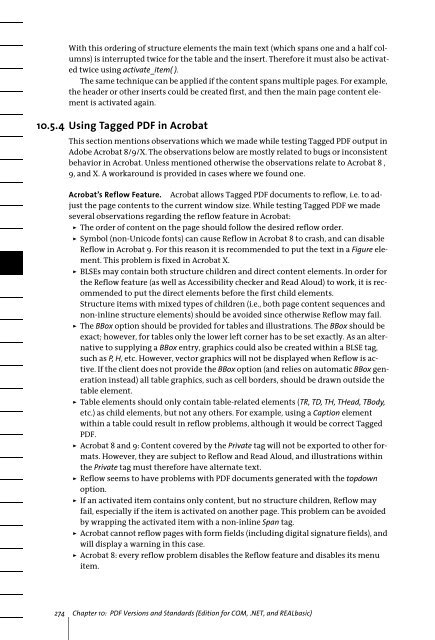PDFlib 8 Windows COM/.NET Tutorial
PDFlib 8 Windows COM/.NET Tutorial
PDFlib 8 Windows COM/.NET Tutorial
You also want an ePaper? Increase the reach of your titles
YUMPU automatically turns print PDFs into web optimized ePapers that Google loves.
With this ordering of structure elements the main text (which spans one and a half columns)<br />
is interrupted twice for the table and the insert. Therefore it must also be activated<br />
twice using activate_item( ).<br />
The same technique can be applied if the content spans multiple pages. For example,<br />
the header or other inserts could be created first, and then the main page content element<br />
is activated again.<br />
10.5.4 Using Tagged PDF in Acrobat<br />
This section mentions observations which we made while testing Tagged PDF output in<br />
Adobe Acrobat 8/9/X. The observations below are mostly related to bugs or inconsistent<br />
behavior in Acrobat. Unless mentioned otherwise the observations relate to Acrobat 8 ,<br />
9, and X. A workaround is provided in cases where we found one.<br />
Acrobat’s Reflow Feature. Acrobat allows Tagged PDF documents to reflow, i.e. to adjust<br />
the page contents to the current window size. While testing Tagged PDF we made<br />
several observations regarding the reflow feature in Acrobat:<br />
> The order of content on the page should follow the desired reflow order.<br />
> Symbol (non-Unicode fonts) can cause Reflow in Acrobat 8 to crash, and can disable<br />
Reflow in Acrobat 9. For this reason it is recommended to put the text in a Figure element.<br />
This problem is fixed in Acrobat X.<br />
> BLSEs may contain both structure children and direct content elements. In order for<br />
the Reflow feature (as well as Accessibility checker and Read Aloud) to work, it is recommended<br />
to put the direct elements before the first child elements.<br />
Structure items with mixed types of children (i.e., both page content sequences and<br />
non-inline structure elements) should be avoided since otherwise Reflow may fail.<br />
> The BBox option should be provided for tables and illustrations. The BBox should be<br />
exact; however, for tables only the lower left corner has to be set exactly. As an alternative<br />
to supplying a BBox entry, graphics could also be created within a BLSE tag,<br />
such as P, H, etc. However, vector graphics will not be displayed when Reflow is active.<br />
If the client does not provide the BBox option (and relies on automatic BBox generation<br />
instead) all table graphics, such as cell borders, should be drawn outside the<br />
table element.<br />
> Table elements should only contain table-related elements (TR, TD, TH, THead, TBody,<br />
etc.) as child elements, but not any others. For example, using a Caption element<br />
within a table could result in reflow problems, although it would be correct Tagged<br />
PDF.<br />
> Acrobat 8 and 9: Content covered by the Private tag will not be exported to other formats.<br />
However, they are subject to Reflow and Read Aloud, and illustrations within<br />
the Private tag must therefore have alternate text.<br />
> Reflow seems to have problems with PDF documents generated with the topdown<br />
option.<br />
> If an activated item contains only content, but no structure children, Reflow may<br />
fail, especially if the item is activated on another page. This problem can be avoided<br />
by wrapping the activated item with a non-inline Span tag.<br />
> Acrobat cannot reflow pages with form fields (including digital signature fields), and<br />
will display a warning in this case.<br />
> Acrobat 8: every reflow problem disables the Reflow feature and disables its menu<br />
item.<br />
274 Chapter 10: PDF Versions and Standards (Edition for <strong>COM</strong>, .<strong>NET</strong>, and REALbasic)
















